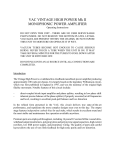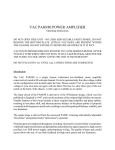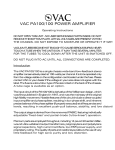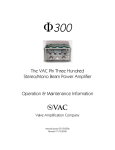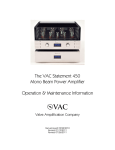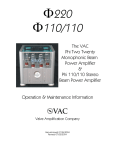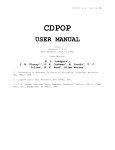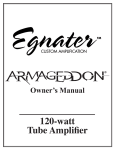Download MartinLogan Sequel II Operating instructions
Transcript
VAC VINTAGE WILLIAMSON POWER AMPLIFIER
Operating Instructions
DO NOT OPEN THIS UNIT - THERE ARE NO USER SERVICEABLE
PARTS INSIDE. DO NOT REMOVE THE BOTTOM PLATES. LETHAL
VOLTAGES ARE PRESENT WITHIN THE CHASSIS. DO NOT EXPOSE
THIS UNIT TO MOISTURE OR OPERATE IT IF WET.
VACUUM TUBES BECOME HOT ENOUGH TO CAUSE SERIOUS
BURNS. NEVER TOUCH A TUBE WHEN THE UNIT IS ON. IT MAY
TAKE SEVERAL MINUTES FOR THE TUBES TO COOL DOWN AFTER
THE UNIT IS SWITCHED OFF.
DO NOT PLUG INTO AN AC SOURCE UNTIL ALL CONNECTIONS
ARE COMPLETED.
Introduction
The Vintage Williamson is a single chassis wide-band low-feedback stereo amplifier
conservatively rated at 35 watts per channel. It is to be operated only from the voltage
labeled on the back of the chassis (100, 120, 220, or 240), 50-60 Hz. Please contact VAC
or your dealer if the voltage in your area does not agree with the label. The fuse is a slow
blow type of the size labeled on the back of the chassis. A tube cage is available as an
option.
The basic Williamson design was first published in England in 1947, and was the mainstay
of the original high fidelity movement. Notable features of this circuit include:
-
direct-coupled input amplifier and phase splitter, resulting in low phase shift
inherent precise balance of the phase splitter (if properly executed) at all frequencies
and level, resulting in excellent push-pull balance and low distortion
a unique bias/balance circuit that allows monitoring and precise adjustment of the
output tubes for maximum power, minimum distortion, and natural sound.
In the refined form presented in the VAC, this circuit delivers true state-of-the-art
performance, and repudiates the more complex designs seen even to this day. The output
stage features independent cathode bias for each tube, which results in excellent sound and
the most stable and maintenance free operation available anywhere.
Premium parts are employed throughout, including 14 pound 22 section bifilar-wound ultrawideband output transformers, polypropylene and polystyrene signal capacitors, high current
rectifiers, low ESR power supply, and proprietary wiring. The quality of parts and careful
layout allows the use of very little feedback for high sonic purity and low distortion.
Unpacking
Each tube socket on the amplifier is covered by a small round sticker. The color of this
sticker corresponds to the color of the sticker on a tube. Fit each tube into the matching
socket, first removing the sticker from the tube and socket. The bias levels for the output
tubes have been factory set, but should be checked during the installation procedure.
Installation
Physical requirements:
1)
2)
3)
4)
5)
6)
Provide adequate ventilation - allow at least 3 inches above and 1 inch to each side.
Do not place in a completely enclosed cabinet.
Do not stack other equipment on top of the VAC units.
Do not operate on carpet or any other surface that might block air flow.
The chassis and power transformers will become hot in normal use.
Do not allow the chassis of the VAC components to touch any metal parts, such as
the frame of an equipment rack. This might create a parallel ground path that will
degrade the sound of your system.
Electrical connections:
1)
2)
3)
Complete all installation steps before plugging the amplifier into the AC mains
supply.
Connect signal inputs to the power amplifiers. Single ended interconnect cables
equipped with RCA phono plugs provide the input to each channel.
Connect loudspeakers between the appropriate pair of binding posts on the back of
the power amplifiers. Most popular speaker cables can be accommodated by the
output terminal strips. Output impedance matching is available for loads of 2, 4, and
8 ohms. Connect one lead of the speaker cable to the "G" position, and the other to
4)
5)
6)
either 2, 4, or 8. The "G" terminal is at ground potential, and the amplifier does not
invert phase.
Do not connect two amplifier outputs to each other.
Connect the AC cord to the power source indicated on the rear panel (100 volts AC,
120 volts AC, 220 volts AC, or 240 volts AC at 50 or 60 Hertz).
Follow the BIAS/BALANCE procedure described in this manual to set the idle
current. Check the idle current at 1 minute, 30 minutes, 1 hour, and 2 hours. Also,
read the section entitled INSTALLING NEW OUTPUT TUBES.
Operation
Continuous operation is not recommended. If the amplifier will not be auditioned for a few
hours it is best to turn them off. This avoids undue stress to the EL34 output tubes.
As with all high fidelity products, the sound characteristics of the VAC amplifiers change
somewhat as they warm up. Best sound will be achieved after 15 minutes of operation, with
subtle changes occurring for up to one hour. However, we advise against leaving the
equipment on at all times because of the attendant acceleration of output tube wear. Life of
the output tubes averages between 2,000 and 5,000 hours depending upon brand fitted and
random variations within the tubes themselves.
Any time that the VAC Power Amplifier has not been used for a few weeks the sound may
be different. This is also normal for high resolution audio equipment. Optimum sound
should return after a few hours of operation, preferably with an audio signal.
Please note that although your VAC amplifiers have been run for 48 hours at the factory,
they will continue to "break in" for approximately 150 hours. Also be aware that many
components display the need for a new break in period after being transported in unheated
cargo aircraft.
Bias and Balance Adjustment
Your VAC Power Amplifier has been shipped with output tube bias preset. This should be
checked when you install your amplifier, and approximately every month thereafter. It must
also be set whenever an output tube is changed.
Monitoring and adjustment of the output tubes is quite easy, and requires a voltmeter
capable of reading in the millivolt range. To start, place the black test lead in the center test
point (TP2) and the red lead in TP1. Adjust the bias control to obtain a reading of 325
millivolts DC (.325 volts).
Next, place the black test lead in TP3. The meter may indicate a positive or negative reading.
Adjust the balance control to read a near to 0 millivolts as possible.
Since the bias and balance controls interact slightly, repeat this procedure two or three times
until the readings are unchanged.
When installing new tubes, adjust the bias and balance controls to the center of their
rotations. Check the bias of both channels as the amplifier warms up - don't wait ten
minutes.
Bias levels should be checked monthly to ensure optimum sound quality. Allow the
amplifier to warm up for an hour before checking. It is not unusual for bias current to change
with time, particularly when tubes are new. In fact, the greatest amount of drift occurs during
the first 200 hours of a tube's life. The drift may change direction periodically, such that the
bias control must be increased and then later decreased, or vice versa. Also check bias if the
sound seems to be lacking in detail or dynamics.
Tube Types
The input/splitter tube V1 and the driver tube V2 may be type 12AU7A/ECC82/E82CC or
type 12BH7 (typically richer sound). The output tubes V3 and V4 may be type EL34/6CA7
or type KT77. Golden Dragon tubes are generally recommended and have been used
extensively during the development of this amplifier. Please feel free to contact VAC if you
require additional information or advice.
Installing New Output Tubes
Replacement tubes are available from VAC and other sources. Output tubes may be EL34
pentodes, 6CA7 beam power tetrodes, or KT77 beam power Kinkless Tetrodes. It is not
necessary that they be matched pairs, although an improvement in measured performance
may be achieved in this way. Make certain that each tube fits firmly in its socket. A tube that
fits loosely may not make correct contact on all pins and might "run away" (read on). DO
NOT MIX TUBE TYPES. DO NOT MIX BRANDS OF TUBES.
ALL POWER MUST BE OFF. Remove the old tubes after they have cooled down (TUBES
BECOME HOT ENOUGH TO CAUSE SERIOUS BURNS WHEN IN OPERATION AND
MAY TAKE SEVERAL MINUTES TO COOL DOWN). Install the new tubes firmly and
fully in the sockets, taking care to observe the direction of the locating ridge on the plastic
center pin of each tube.
Follow the normal turn on procedure and begin the BIAS procedure. While doing this, keep
an eye on the plate (the outermost metal structure) of the output tubes. SWITCH OFF
IMMEDIATELY IF THEY BEGIN TO GLOW RED. This indicates that the tube is
"running away", being destroyed rapidly by conducting excessive current. (Note: with some
KT77s a slight dull orange glow may occur over a very small section of the plate, usually
at an edge. This is acceptable and not the same as running away, in which most of the plate
will become bright orange or red.)
Tubes may run away for several reasons:
1)
The tube is not fully inserted in the socket.
2)
The tube fits loosely in the socket and thus can not make correct contact. Such a tube
is unusable and should be returned to its seller.
3)
The tube is defective.
4)
The bias is misadjusted.
5)
There is a problem with the amplifier. Contact VAC or your dealer to arrange service.
In the event that trouble is encountered, try another tube. Stop if the problem persists and
consult with your dealer or VAC.
Follow the BIAS procedure described previously in this manual to set the idle current at 70
milliamperes per tube, checking the idle current at 1 minute, 30 minutes, 1 hour, and 2
hours.
Replacement of Low Level Tubes
All power must be switched off. Allow tubes to cool down. Remove and replace with new
tubes of the appropriate types, noting the location of holes in the socket and pins of the
tubes.
Replacement tubes are available from VAC and other sources.
Ultra-linear or Triode?
The input amplifier, phase splitter, and driver stages are triode tubes operated in Class A
with no cut-off or grid current. The output stage is connected for partial-triode, well known
for low distortion, good damping factor, and high efficiency. This technique was invented
by Alan Blumlein of EMI in England, and was popularized in the US as "ultra-linear." It is
simple for a qualified service technician to connect the output stage for triode operation.
Directions will be provided upon request.
Care of Chassis & Face Plate
VAC chassis are aluminum for superior electromagnetic performance. The face plate is
finished in either highly polished black acrylic lacquer or a tough textured gloss powder coat
paint. This finish is durable but can be scratched or chipped, just as that of a fine automobile
may be damaged. Cleaning with a damp cloth WHILE THE AMP IS SWITCHED OFF
AND UNPLUGGED should suffice.
When shipping your VAC amplifier, be certain to wrap the face plate in the cloth or tissue
originally shipped from the factory. Take care to ensure that there are no ridges in the cloth.
Use of a harsher cloth or the presence of deep wrinkles in the cloth may result in abrasion
of the finish.
The brass plates on your amplifiers may have been shipped from the factory with a
protective film covering, which should be removed for best appearance.
Tube Cages (Optional)
Perforated metal cages are available to enclose the vacuum tubes and transformers. They
attach with the two black headed screws located on each side of the chassis.
Need Help?
Please call us with any questions you may have. It is better to ask than to guess.
Warranty
This amplifier is warranted for a period of thirty (30) days from the date of purchase. In
addition, if the registration card(s) is received by VAC along with a copy of your sales
receipt from an authorized VAC dealer within this thirty days, a service contract will be
extended to cover your equipment for two (2) years (except tubes which are covered for 90
days). Receipt of your registration card will be confirmed in writing by VAC.
This warranty applies only to units sold and operated in the United States of America
through authorized VAC dealers. For warranty information outside of the U.S. contact the
importer of VAC equipment for your country. Units sold outside of the U.S. should still be
registered with VAC.
REGISTRATION FORM
Vintage Williamson Mk II
Name
_________________________________________________________________
Address
_________________________________________________________________
_________________________________________________________________
Telephone
_______-_______-__________________
Dealer name __________________________________ Salesperson ____________________
" address
______________________________________________________________
Purchase date ___________________________
Serial Number___________________
How did you first learn of VAC products? __________________________________________
Please provide any comments on VAC products or your dealer _________________________
______________________________________________________________________________
______________________________________________________________________________
______________________________________________________________________________
______________________________________________________________________________
Tips & Advice
A Word About Tubes in General
It is a truth that each brand of tube sounds different in a particular high resolution circuit.
This is because no two manufacturers make a tube type in quite the same way, and the
central tendencies of the performance parameters will differ slightly with each maker. To
emphasize the point, examine the plate structure of any two 12AX7 from different
manufacturers will probably find that they may not even the same shape and size. (Be careful
here, as often a tube is made by a firm other than indicated on its label. In the heyday of
tubes it was common to crossbrand between major labels, such as GE and RCA. Today
many labels do not manufacture their tubes at all, including Gold Aero and RAM.)
This sonic variability may at first seem a liability, but further thought will reveal that it is an
advantage, just like the ability to adjust VTA on a tone arm. The owner of a tube amplifier
can select those tubes which sound like the real thing in his/her specific system. Of course,
if the manufacturer you prefer is rare you may want to purchase a few spare tubes for the
future.
How long should tubes last? It has long been known in professional circles (and probably
now forgotten) that a tube such as the 12AX7 will display better performance characteristics
after two years of continual operation than when it was new. In normal use it is not unusual
for a low level tube to last 10 years or longer. Output tubes are another story, as they are
continually providing significant amounts of current. Here the sound is your best guide.
Certainly tubes should be replaced when the amplifiers can no longer meet specifications
or when (if you have access to a tube tester) the tube's emission is significantly down or its
transconductance is substantially out of specification. In normal use, output tubes will last
at least 2 years and perhaps more than 10 years.
VAC will be happy to test tubes for concerned customers, providing transconductance, idle
current and/or a photographic record of the tube's plate family curves.
TIPS & ADVICE
A Word About Output Tubes
Your VAC Amplifier can use 2 different output tube types: the KT77 Beam Power Tetrode
and the EL34/6CA7 Power Pentode. From the engineering perspective, beam power tubes
have sharper "knees" to their plate characteristics, more second harmonic distortion, less
third harmonic distortion, and are somewhat less tolerant of load impedance mismatches. We
consider the sound of the KT77 to be superior. Feel free to experiment with different brands
and types to customize the sound to your tastes.
As with interconnects and speaker cables, each tube manufacturer's EL34 tends to have a
distinct sound when used in VAC amplifiers, and of course the KT77 sounds different as
well. Here is a brief summary of our experiences with currently available tubes from
different sources.
M-O Valve Company/Genalex/GEC KT77 (U.K.):
Accurate and dramatic imaging, great nuance, control of dynamics, sweetness, and
bass quality. Quality is surprisingly variable for a premium tube, and we have had to
reject about 10% of the KT77s we have purchased. Most EL34s are more harsh
sounding by comparison. World wide supply is limited. Highly recommended.
Golden Dragon EL34 (B):
A new version of the EL34 designed in Great Britain and manufactured in China. A
very good tube, much more open, detailed, and dynamic than the East German EL34,
with superb bass performance. Highly recommended.
Gold Aero KT77:
Depending on vintage this can be a relabelled GEC KT77 or an EL34 with the KT77
name rolled onto it. Take care. We recommend staying with tubes that are accurately
labelled.
Russian & German Made KT77:
EL34 variants. Not recommend.
Siemans, EUI, and National EL34 (Germany):
Detailed bass and energetic treble. Good detail. May be too cold or harsh sounding
in some systems. Some recent authors have cast suspicion over this tube due to the
slimness of its design, claiming that it is less durable than versions in a larger bulb.
Do not worry. This style of tube is the original EL34 as made by high quality firms
like Amperex, and occasionally imported by GE. Recommended.
GE EL34/6CA7 (applies to those manufactured in USA by MPD):
Robust tube with bass similar to better solid state amplifiers. Overall a bit wooly
sounding. This is one of the large bulb variants of the EL34, and is actually a beam
power tube.
EI EL34 (Yugoslavia):
Similar to the East German tube, but inferior in most respects. Has unique exhaust
tip on the top. Not recommended.
Chinese EL34J (available from Penta, Gold Aero, Richardsons, & others):
Good detail and very liquid sound, this tube may seem a bit soft and bright in some
systems. We have been unable to confirm rumors of unreliability.
TIPS & ADVICE
A Word About Low Level Tubes
The small tubes (Voltage Amplifier/Phase Splitter and Driver) in the VAC Amplifiers are
type 12AU7. This tube is essentially the same as types 12AU7A, 5814, 6189, CV4003,
ECC82, and E82CC. The quality of the tube used is by far more important than which of
these (equivalent) types is used.
The preferred 12AU7A is the British/Chinese Golden Dragon. Acceptable alternate versions
include the Brimar CV4003 (ladder plate version), Mullard CV4003 (very midrangy),
generic Chinese 12AU7 (brighter), Sylvania 6189 (darker sound), the GE 12AU7A (slightly
forward and grainy) and the Yugoslavian 12AU7 (cohesive and somewhat coarse).
Many classic tubes worth trying if you have access to them, such as those from Telefunken
and Amperex, although a caution is in order, as we have recently seen East German EL34
relabelled "Telefunken West Germany." Tubes actually manufactured by RCA,
Westinghouse, and Sylvania can be quite good, but the name on the tube doesn't always
indicate who actually made it. Other names to watch for are Valvo, Mazda, Tung-Sol,
Bendix, Mullard, Brimar, and Raytheon.
TIPS & ADVICE
A Word About Bias Levels
The output stage is designed to operate in rich Class AB1 at an idle current of 65
milliamperes per tube, at approximately 500 VDC on the anodes and 460 VDC across the
tubes. For more technical information about classes of operation see VAC Technical
Monograph 90-8.
Some designers erroneously market a lower voltage and current operating point (as little as
26 mA) as "Class A1." Be assured that the VAC and its tubes are strong enough to handle
the more demanding, richer bias level. However, if you prefer the slightly greater tube life
predicted by a lower idle current, you may adjust the bias level down somewhat lower, being
sure to keep all four tubes at the same level. If you do, experiment with the output
impedance connections for best sonic results.
TIPS & ADVICE
A Word About Impedance Matching
We strongly suggest that you experiment with the three available impedance connections for
the best sonic match with your system. Since no loudspeaker represents an unchanging
impedance at all frequencies, it is impossible to assert with certainty which output tap is
appropriate to use. In many systems an amazing difference in sound will exist between the
various impedance taps.
You should consider the output impedance markings on your VAC Power Amplifier as
follows:
"8 ohms" matches loads between 4 ohms and 8 ohms
"4 ohms" matches loads between 2 ohms and 4 ohms
"2 ohms" matches loads between 1 ohm and 2 ohms
Most loudspeakers vary outside of any one of these ranges, which is why experimentation
is essential. We often find that matching a speaker's minimum impedance is more important
than matching its nominal (average) impedance.
If you bi-wire your system (run separate speaker leads from the amplifier to the high and low
frequency transducers) you may discover that two different impedance taps work best. For
example, with early Martin Logan Sequel II we find that the bass speaker is best matched
with the 4 ohm tap, while the electrostatic panel is best controlled by the 2 ohm tap. To
achieve this connection, the black leads of both speaker cables connect to "G", the red lead
for the panel connects to "2", and the red lead for the woofer connects to "4". With later
Sequels we use the 4 ohm connection for both drivers.
Contrary to popular misconception, no power is lost due to unused output taps. Also, the
amount of negative loop feedback in the amplifier does not change, being fixed at
approximately 8 decibels for all output taps. For more information consult VAC Technical
Monograph 90-9.
TIPS & ADVICE
A Word About Output Stage Operating Mode (triode internal wiring option)
Triode amplification is the oldest form known, while partial triode ("ultra-linear") operation
of pentodes and beam power tubes dates to 1937. From the engineering perspective, the
triode mode differs from the ultra-linear mode in the following ways:
1)
2)
3)
4)
5)
Somewhat more distortion at low power levels
Somewhat less distortion at moderate power levels
Reduced maximum power output
Output impedance matching is somewhat less critical
Increased damping factor.
The ultra-linear mode applies negative voltage feedback from the primary of the output
transformer to the screens of the output tubes. The ultra-linear circuit displays different
characteristics (efficiency, distortion components and levels, etc.) depending upon how
much of the primary winding is common to both the screen and plate of the output tubes.
The VAC implementation of the ultra-linear circuit has been selected to achieve
performance quality as close to pure triode as possible while still increasing power output
and efficiency.
VAC can provide directions allowing a skilled technician to convert the output stage to
triode operation.
SPECIFICATIONS
The VAC System has been developed with the critical ear as the major arbiter of quality,
with both conventional and unique measurements providing insight and guidance as
necessary. The lack of emphasis on measurements is due to the fact that engineering's
arsenal of equipment and techniques do not operate on the pattern recognition principals that
control human perception of sound.
In the immortal words of Daniel von Recklinghausen, if it measures good and sounds bad
it is bad. If it measures bad and sounds good you've measured the wrong things.
For those concerned with test bench performance, the following describes typical measured
performance of a Vintage Williamson operated at 120 VAC, 60 Hz.
Power Output:
37 watts continuous average power at 1 kHz with less than 1%
THD into 8 ohms connected to the 4-8 ohm tap, both channels
driven.
Frequency Response:
down 0.5 dB at 6 Hz and 55 kHz, ref 0 dB = 1 watt @ 1 kHz.
(Note: response peaks will be observed at approximately 68 kHz and 190 kHz. Such peaks
are present in all tube type transformer coupled power amplifiers, and are normally
suppressed by the use of a phase compensation network in the negative feedback loop. VAC
has deliberately avoided this technique, finding that it is sonically inferior to the slight
ultrasonic peaks encountered with an excellent output transformer. The compensation
technique looks good into a resistive load, but falters in the real world. Interested
audiophiles should see Some Defects in Amplifier Performance Not Covered by Standard
Specifications by Norman H. Crowhurst, published in the October 1957 Journal of the
Audio Engineering Society.)
Power Bandwidth: down 0.5 dB at 15 Hz and 33 kHz, ref 0 dB = 35 watts @ 1 kHz.
down 3.0 dB at 11 Hz and 55 kHz, ref 0 dB = 35 watts @ 1 kHz.
Distortion:
< .2% THD at 1 kHz 10 watts
Noise:
S/N ratio > 84 dB
Sensitivity:
.8 volts input for full power output
Negative Feedback: Loop feedback is fixed at approximately 8 dB regardless of output tap
selected.
Absolute Polarity: Does not invert signal polarity.
Fuse:
Slo-Blow type, 3.15A for 100 & 120 Volt configuration.














